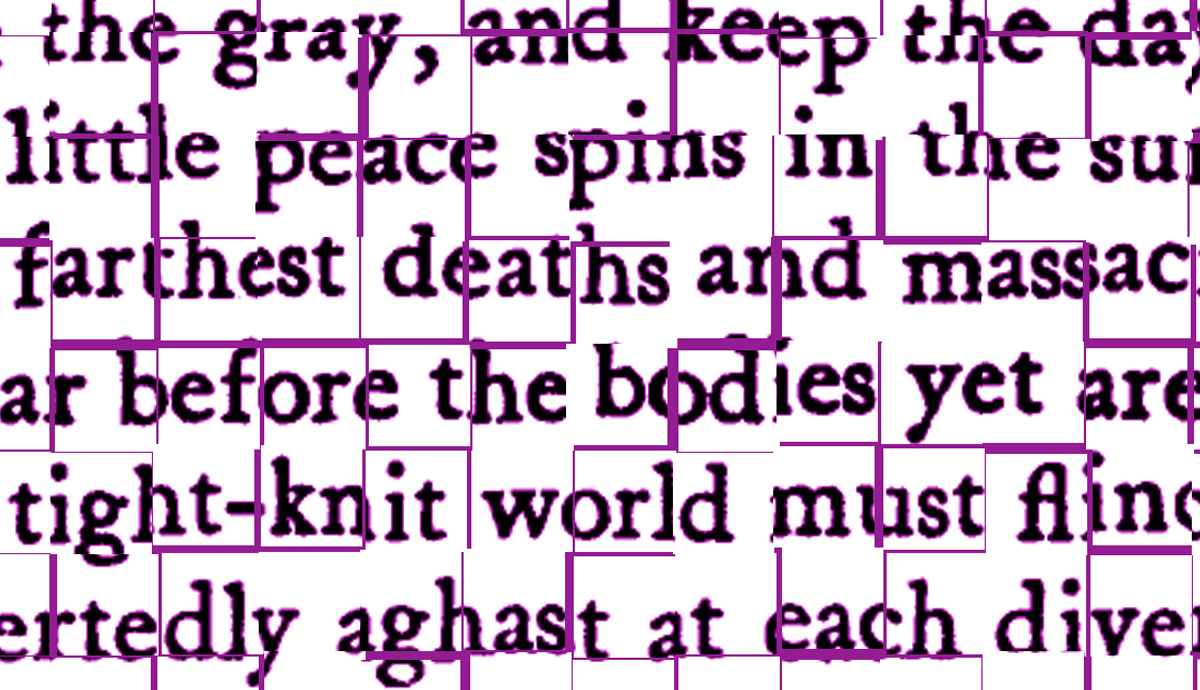As a queer writer it seems impossible that I lived in Water Valley, Mississippi for over a decade before I ever heard the name Hubert Creekmore.
A gay intellectual who studied Rimbaud, graduated from Ole Miss, worked for New Directions, wrote social-justice fiction, and grew up in a house that I walked past every day—how could I have missed our very own Eudora Welty, our own William Faulkner?
The answer, I soon learned, was simple: Water Valley had spent the last 50 years deliberately trying to erase his memory, and there were no Southern Agrarians, no Malcolm Cowley, to bail him out like they rescued Faulkner.
Where Faulkner was brash, exploitative, and personally inauthentic, Creekmore was sensitive, sincere, and multifaceted. And while Oxford has carefully cultivated its image of Faulkner since his death, it took Water Valley until 2015, with the dedication of the Creekmore home as a state historical monument, to begin reclaiming Creekmore.
Creekmore has fascinated me since the moment I encountered him. His work is often characterized as documentary-style and didactic, and despite a long career of publishing work he died in 1966, virtually unknown, in a taxi on the way to the airport. In the shadow of Faulkner, alongside his wildly successful cousin Eudora Welty, why did Creekmore’s project fail, and what does it mean to reclaim it?
His career began with poetry. “Thieves” was published in the North American Review in 1933, when he was still in grad school. “Formula 9” and “Outdoor Movie—Noumea” were both published after the war, where Creekmore served in the South Pacific.
Thieves
Often have I wished to chain the dawn
below horizon’s rim, attenuate
the tranquil moments of its blushing stain
upon the gray, and keep the day at naught.
Too little peace spins in the sun of noon.
The farthest deaths and massacres are mine
to bear before the bodies yet are cool.
The tight-knit world must flinch in every mile
concertedly aghast at each diverse
atrocity. I have my own deep source
of sorrow and would tend its jealous hurt
without encroaching pleas to pay my court
to others’ ills. The wind and sun must merge
as solitary mine before they purge.
—North American Review, 1933
“Formula 9”
In the red ravine, locust-tree roof
And a million minute chandeliers of white
Censing the air in spring
White sand floor on the gully floor,
Barefoot sqush by the crawfish holes
And the ouch of sycamore balls
On the long upslope, jungle-deep bluff
Tumbling to bog and moccasin scum
And the giant tulip-tree in bloom
In the desert of green the isolate call
Here Rosa, heah!” to foraging cow
Lost in the pasture’s edge
Brown hide sheen, bristle-soft light
Liquid moo, and a boy in wordless wonder
To and from the pasture.
—Formula, 1947
Outdoor Movie—Noumea
The senile shadow of a vigorous time
Lurks about the mountain slope.
Whining for distant days
We crowd the amphitheatre to gaze
At shadow actors who will mime
The modern satyr play.
Strophes from the mask of celluloid
Curl with promise through the tiers.
Cothurnus in high heels
Tapdances to the cymbals, and ordeals
Of love drench those lips enjoyed
But never touched by ours.
Around our emptiness we draw the disguise
Of movies. Oh, men at Thermopylae,
This hero is a ghost.
And all are lost upon the hillside, lost
Beneath the dance of gigantic thighs
Projected on our will.
Shadows, watching shadows, imitate,
Drain their dwindling substance through
Each others’ pallid cores.
Beyond the eastern range the great moon pours
On screen of clouds, then breaks, great
Cascade of longing, to
The desert of our dreams, breaks that screen
Hiding the world of man from man,
And probes the only real
We know within ourselves. Its mirrors steal
Us from the hypnotist. The lean
Sinews knot and wake.
—Formula, 1947
•
My decade of ignorance turned into a frenzy of catching up, and I now own every Creekmore book except one: 1948’s The Welcome.
A quiet, pained story about a gay relationship in the fictional Water Valley analogue of Ashton, The Welcome found popularity in the LGBTQ+ community 20 years ago, and is now the rarest Creekmore publication. It’s almost impossible to find—and, but not for this reason alone, arguably the most ripe for a reprint.
Like all his novels, The Welcome moves freely between multiple perspectives between men and women, adults and children, but it most closely follows a failed writer named Don, who returns to Ashton to take care of his mother. Don’s former lover, Jim, is stuck in a nightmarish marriage, and neither man understands how to help the other, let alone themselves.
Contemporary reviews marketed the book somewhat positively as a critique of middle-class marriage, erasing the inherent queerness of the text, but the narrative itself can be surprisingly frank about its sexuality. It’s no City of Night, but then again Water Valley is no Los Angeles, and if the reader has any illusions about Don and Jim’s relationship, the characters themselves certainly don’t.
In the following passage, quoted from the second half of the book, Don shares the memory of his first erotically-charged encounter with Jim, documenting the kind of formative (queer) boyhood moments that are surprisingly common in southern literature (and that recur in Creekmore’s next novel, The Chain in the Heart).
Don was Tarzan, swinging for the branches and standing upright where they were broad enough, and Jim, crouching and gibbering, was Kala, his ape foster mother. And there, walking barefoot one day along a limb without holding to those above his head, Don slipped. Jim saw his right leg scrape to the groin while the torso swung in an arc and Don crashed through the leaves to the porous moss and mold on the bluff. While he scrambled in an agony of dread and love down the tree, he glimpsed Don rolling spasmodically to the bottom of the bluff, just as men did in the movies; and suddenly he knew, running after him, that their play acting had come true. He was now truly Tarzan’s foster mother, racing to save him. The old serials would have announced: “To Be Continued”; but Don lay below and he couldn’t wait. In a spray of dirt and dead leaves he slid to his side and hugged him close, whispering, “Don, Don, are you hurt? Don?” When Don groaned something indistinct, he felt relieved. Then Don moved his hand toward his thigh. “My leg... oh...”—and added in a shaking voice—“It knocked the breath out of me.” Jim tried to roll up the trousers but they were too tight, and he opened them and drew them down to show the wide scrape on the inside of the leg. He wiped it awkwardly with his shirttail where the blood was oozing. “I—I thought you were killed,” he said. “I’ll carry you back. You must’nt walk on it.” “Aw, shucks, sure, I can.” And Don got up stiffly to go...
—The Welcome, 1948
In the next passage, Creekmore can be seen gesturing towards a multitude of non-normative romances and lifestyles—men and women across Water Valley whose only commonality is their failure to fit into midcentury Mississippi marriage paradigms.
Creekmore himself was able to leave Water Valley for New York City. The Welcome is about the people who had to remain.
The same loneliness she sensed in many people all about her, the unfulfilled urge, at least of the body, and the hungering quest of the personality. Miss Rosa Walker at the drugstore, daringly reaching to Dr. Everett; Miss Julia, the accountant, and Miss McKinney, the stenographer, defeatedly clinging to each other; Alice Barnette and Anita Leffingwell, despairingly making their last feeble attempts. And there were the men, too—Horace Saxon, the widower Judge Dorn—lonely and no doubt puzzled, as far as she knew, longing for the union which would help them to express their lives. But why had all these been forsaken, what had happened to their little world that marriage had become more difficult, not only to achieve, but to sustain? For both husbands and wives seemed to revolt from its demands, as if it were an outmoded custom to which neither wanted to conform more than for preliminary requirements.
*
I went into my reading of Creekmore’s last novel, The Chain in the Heart, with extreme skepticism. It was one thing for a closeted white man to tackle the 20th-century queer experience—it was quite another to tackle the 20th-century African American experience.
Despite my misgivings, The Chain in the Heart is useful both as a Creekmore novel and as a “novel about race.” It’s sensitive in its racial language, limiting in its use of Twain-style dialect markers, completely unburdened by white perspectives, and attuned to the intractable politics of race and colorism we’re still caught up in today.
Like a straight-faced Invisible Man, its characters move through a what’s-what of early 20th-century history—the terror of reconstruction, great war, great depression, labor strikes and union breakers, communism, black nationalism—but, where Invisible Man is doubled-over laughing, Creekmore is more sentimental than ever. Ellison once said that white readers are too sentimental about race to read Invisible Man correctly, and there can be no doubt about it: Creekmore is a sentimental reader.
It also has a lot in common with contemporary classics by likewise under-observed writers, like Ann Petry’s The Street and Jean Toomer’s Cane, although I’d recommend reading similar books by writers of color before taking the time for The Chain in the Heart, even if they do have a particular interest in Creekmore.
For the budding Creekmore scholar, The Chain in the Heart is the most in-depth display of Creekmore’s style: the clear, documentary-like unfolding of places and events, the effortless fluidity of perspective, the quiet allusions to queer sexuality (and relentless toxicities of heteronormativity), its setting in Ashton, and even its commitment to using real headlines from the North Mississippi Herald, Water Valley’s weekly paper still in circulation today.
Citing the Herald in his novels is the smoking gun of Creekmore’s social critique: he’s probing the real North Mississippi with a deliberation that Faulkner was never really interested in doing, which leads to a very direct social challenge. Didactic or not, his subsequently clear-headed condemnations of homophobia, racism, and misogyny in midcentury Mississippi are as fruitful today as they were in 1953.
For George knew all the while that his father was dead not because he murdered, or raped or even insulted a white lady, but simply because he struck back. He and May had seen the report in the paper. The tall headlines, just below the motto “Justice, Truth and God,” said: “NEGRO BRUTE COMMITS SUICIDE BY COWARDLY ATTACK ON WHITE MAN,” and they could read no further. But when they read the editorial that appeared the following week, they had no doubts as to the interpretation of the unspecific apologetic tone. “The Herald is the friend of the colored man,” it began, with citations of proof, and went on: “But remember—the white man is the most cruel and savage beast that inhabits the earth. God made him such. He will rule in his sphere or he will die in the attempt. Arouse his hatred and animosity and he will exterminate you. He has cruelly destroyed every race and people that has challenged his right to rule. But remember, if the white man can be cruel, he can also be just.” Then there followed directions on how to insure this justice, but they were too familiar to George and May to rouse them to the desire. Both agreed from the beginning never to let any of their families know what the paper had said; all of them had suffered enough already.
This post was adapted from a presentation at the North American Review Writing Conference on April 21, 2019.



